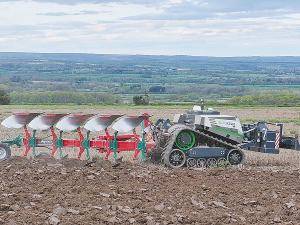Kverneland to debut Alentix fertiliser spreaders at Agritechnica
With Agritechnica just around the corner, it’s no surprise to see manufacturers drip-feed some information of new products worth a closer look.
 The 24-hour autonomous ploughing challenge involved a driverless AgBot 5.115T2 pulling a fivefurrow Kverneland plough.
The 24-hour autonomous ploughing challenge involved a driverless AgBot 5.115T2 pulling a fivefurrow Kverneland plough.
While ploughing appears to become less fashionable than minimal tillage, it remains an important process in many areas.
Indeed, with blackgrass becoming a major problem for many cereal growers, ploughing has become a solution to break the growing cycle.
The future of ploughing was recently demonstrated with major plough manufacturer Kverneland setting the first world record for autonomous ploughing by teaming up with autonomy solutions provider, AgXeed.
The 24-hour autonomous ploughing challenge took place in Stonegrave, North Yorkshire, in the UK, achieving an output of 20.8ha (51.37 acres) using a driverless AgBot 5.115T2 pulling a five-furrow Kverneland LO 300/85 plough.
Working on-land, at 16-inch (40cm) furrow widths, at a depth of 9-inches (22.5cm) preparing ground for maize and fodder beet, the 156hp rubber-tracked autonomous AgBot operated at forward speeds from 5.6kph up to 8kph on the rolling land, slowing only to carry out headland turn sequences. On-board telemetry from the AgBot indicated fuel consumption from the diesel-electric powertrain totalled 382.72 litres over the 24-hour period, a figure of 18.4 litres/ha.
Adam Burt, Kverneland UK’s product specialist for ploughs said, “The combination of the Kverneland LO plough and AgBot achieved an output that would have taken two working days to complete with an operator using a similar powered tractor pulling a five-furrow plough.”
He went on to explain that equipped with Kverneland No.28 bodies, the LO plough is one of the easiest on the market to pull, with its low draft delivering low fuel consumption and a highquality finish. Burt also highlighted the efficiencies available from using autonomous tractors for repetitive tasks.
The AgBot stopped momentarily during the night, to top-up its 375- litre fuel tank to complete the 24-hour work period. Ironically, the total area ploughed during the challenge was verified by local farmer and well-known ploughman, James Whitty, who was World Champion in 2003.
AgXeed UK sales manager, Peter Robinson, commented, “Having mapped the field boundary and created a job map complete with headland turns sequence, the AgBot worked tirelessly for 24 hours,” said Peter Robinson.
“The event has proved that autonomy is not just for just mundane, repetitive tasks, but can also be applied to more complex processes, such as ploughing.”
With multi-layer security systems built into the AgBot for operational safety, the 7-tonne tractor was equipped with a 1.5-tonne front weight to improve traction for the fully mounted plough.
A New Zealand dairy industry leader believes the free trade deal announced with India delivers wins for the sector.
The Coalition Government will need the support of at least one opposition party to ratify the free trade deal with India.
Primary sector leaders have welcomed the announcement of a Free Trade Agreement between India and New Zealand.
At Pāmu’s Kepler Farm in Manapouri, mating has wrapped up at the across-breed Beef Progeny Test.
More than 150 people turned up at Parliament recently to celebrate the 20th anniversary of Horticulture New Zealand (HortNZ).
Biosecurity New Zealand says Kiwis should continue to keep an eye out for yellow-legged hornets (Vespa velutina) over the holiday season.

OPINION: The release of the Natural Environment Bill and Planning Bill to replace the Resource Management Act is a red-letter day…
OPINION: Federated Farmers has launched a new campaign, swapping ‘The Twelve Days of Christmas’ for ‘The Twelve Pests of Christmas’ to…